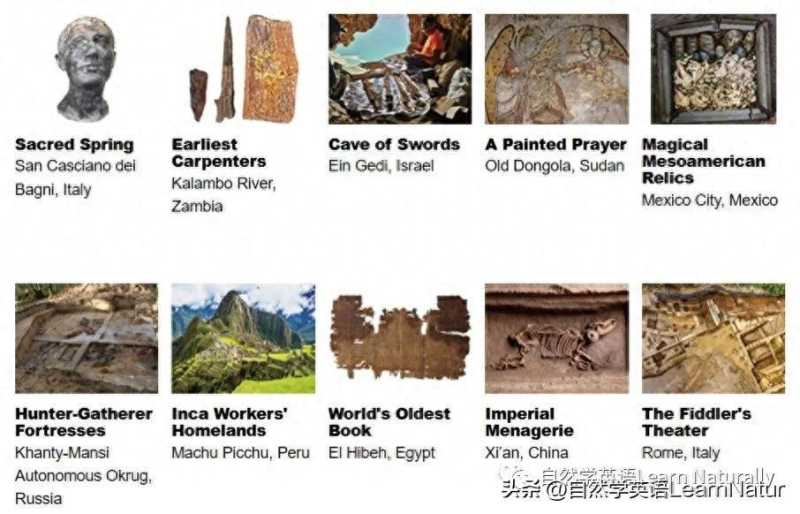英闻独家摘选: 2023「全球10大考古发现」揭晓!
Today, tomorrow, learn English naturally. 天天自然学英语

Top 10 Discoveries of 2023
1.Earliest Carpenters
Rarely has a single find changed scholars’ views of the capabilities of people of the past as radically as the discovery of the world’s earliest known wooden architecture, which dates to nearly half a million years ago. The pair of interlocking logs joined by an intentionally cut notch was unearthed beneath a bank of Zambia’s Kalambo River by a team led by University of Liverpool archaeologist Larry Barham. Researchers believe the logs may have formed part of a walkway or the foundation of a platform built over wetlands. Prior to this discovery, the oldest known surviving wooden structures were built by people living in northern England around 11,000 years ago.
The 476,000-year-old log structure predates the appearance of the first modern humans by some 150,000 years and was likely the handiwork of the archaic human species Homo heidelbergensis. Paleoanthropologists believe H. heidelbergensis was highly mobile. Thus, it is surprising that the hominins would have invested labor in building a semipermanent structure. “We haven’t seen archaic humans manipulating their environment on such a large scale before,” says Barham. “It suggests an attachment to a single point on the landscape.”
At the same site, the team unearthed stone axes as well as four wooden tools dating to between 390,000 and 324,000 years ago. These included a digging stick, a wedge-shaped object, a notched branch, and a flattened log. Marks on the log, notes Barham, resemble nothing so much as tool nicks on a work bench, inviting speculation as to what other structures an imaginative H. heidelbergensis woodworker might have fashioned.
2.Cave of Swords
In a cave near the ancient settlement of Ein Gedi on the banks of the Dead Sea, archaeologists from the Israel Antiquities Authority have discovered an assemblage of four extremely well-preserved iron swords. For the investigators, just getting to the cave was a challenge, as it is located around 500 feet up a remote cliff face. Accessing the swords required reaching deep into a narrow crevice in the cave’s upper section. The three longer blades, which measure between 17 and 25 inches, are spatha swords, which replaced the shorter gladius as the primary weapon used by Roman mounted and infantry troops. The shortest weapon is a ring-pommel sword, which was also commonly used by Roman soldiers stationed in the ancient province of Judea beginning in the first century A.D. Three of the weapons were still sheathed in their original wooden scabbards.
Israel in a cave near the ancient settlement of Ein Gedi on the banks of the Dead Sea, archaeologists from the Israel Antiquities Authority have discovered an assemblage of four extremely well-preserved iron swords. For the investigators, just getting to the cave was a challenge, as it is located around 500 feet up a remote cliff face. Accessing the swords required reaching deep into a narrow crevice in the cave’s upper section. The three longer blades, which measure between 17 and 25 inches, are spatha swords, which replaced the shorter gladius as the primary weapon used by Roman mounted and infantry troops. The shortest weapon is a ring-pommel sword, which was also commonly used by Roman soldiers stationed in the ancient province of Judea beginning in the first century A.D. Three of the weapons were still sheathed in their original wooden scabbards.
Why the swords were hidden in the cave is unknown, although a coin found near the entrance may provide some clues. The bronze coin includes an inscription reading “For the freedom of Jerusalem” and likely dates to A.D. 134 or 135. This coincides with the Bar Kokhba Revolt, in which Jews rebelled against Roman rule. Researchers believe that local rebels may have taken the swords from Roman soldiers and stashed them away in a secret hiding spot to be used in the conflict.
3.A Painted Prayer
While investigating a house dating to the sixteenth century in Old Dongola, once the capital of the medieval Nubian Kingdom of Makuria (ca. A.D. 400–1400), a team from the Polish Centre of Mediterranean Archaeology at the University of Warsaw discovered a puzzling network of rooms beneath the floor. On the walls of one of these rooms—a narrow, vaulted space measuring just three feet wide and nine feet long—archaeologists found several unorthodox paintings that they believe date to the thirteenth century. One of these paintings portrays the Virgin Mary. Another depicts a scene in which the archangel Michael holds a Nubian king in his arms and presents him to Jesus, who sits on a cloud and extends a hand for the king to kiss. “This is completely uncommon for Byzantine Christian art, which generally does not show a lot of interaction or contact between mortals and immortals,” says team leader Artur Obłuski.
Researchers suspect this tableau is connected to a fateful moment in Makurian history. An Old Nubian inscription accompanying the scene includes several references to a king named David as well as a plea to God for protection of the city. Obłuski says it’s likely that the painting portrays the Nubian King David who, for unknown reasons, launched an attack on the Mamluk Sultanate of Egypt in the late thirteenth century. Although the campaign met with some initial success, in 1276 the Mamluks struck back forcefully and were advancing on Dongola. “I see this wall painting and inscription as a prayer, as a call to God when the Mamluk army is approaching,” says Obłuski. “At this moment, the king prays to God to protect the city he loves, the city of Dongola.” The plea fell short, as the Mamluks sacked Dongola and eventually captured and executed King David.
4. Magical Mesoamerican Relics
The Templo Mayor, including the massive pyramids at the heart of the Aztec, or Mexica, capital of Tenochtitlan, is like a Russian doll, says archaeologist Leonardo López Luján of Mexico’s National Institute of Anthropology and History. “When you dig within a Mesoamerican pyramid, you find another that is older and smaller,” he says. In the ninth of 13 total layers, López Luján and his team have uncovered a small chest made of volcanic stone that, like the Templo Mayor complex itself, contains many layers of meaning. Inside the chest, they found 15 perfectly preserved anthropomorphic figurines made of serpentine, along with Aztec symbols of water and fertility such as marine sand, a pair of rattlesnake-shaped scepters, hundreds of greenstone beads, and seashells, snails, and coral. The layer of the temple in which the chest was found dates to the year 1 Rabbit, or 1454, when, under Moctezuma I (reigned 1440–1469), the temple underwent one of its most impressive expansions. But the figurines were already 1,000 years old at the time and had been brought to Tenochtitlan from around 200 miles away.
These types of figurines were typically produced from around 500 B.C. to A.D. 680 by the Mezcala people, who were based in an area that is now in the southwestern Mexican state of Guerrero. In their most sacred space, the Aztecs made the objects their own by embellishing them with paint and placing them in the chest as offerings to their rain god Tlaloc. “Tenochtitlan was the center of the Mesoamerican world,” says López Luján. Objects were brought from all of the provinces of the empire, and even beyond its borders. “The Mezcala figurines were considered by the Aztecs magical relics from the past,” he says. “Many of these offerings are cosmograms, or representations in miniature of the universe as conceived by the Aztecs. The chest and its contents symbolized a mythic realm known as Tlalocan which was re-created by Templo Mayor, where the rain god kept water and sustenance.”
5.Sacred Spring
At the beginning of the first century A.D., lightning struck a sanctuary at a site known as Bagno Grande, or Large Bath. For centuries, the thermal pool there had been sacred to both Etruscans and Romans. When lightning hit, the sanctuary’s priests were compelled, according to both Etruscan and Roman beliefs, to bury under a layer of terracotta tiles hundreds of votive offerings that had been brought by pilgrims over the years. This ancient ritual, known as fulgur conditum, or “buried thunderbolt,” was intended to seal the objects in and mark the spot as especially sacred. Archaeologist Jacopo Tabolli of the University for Foreigners of Siena describes the discovery of these offerings, which include bronze statues of men, women, children, divinities, and individual body parts, as a complete surprise. “We knew from archival sources that in the 1600s and 1700s there was a thermal spa close to Bagno Grande,” he says, “but we had no idea it was an ancient sanctuary.”
Among the rarest finds are 14 large bronze statues, some of which bear dedications to gods including Apollo, Asclepius, Hygeia, Isis, and Fortuna Primigenia, who are all associated with health and healing. As important as the individual artifacts, explains Tabolli, is the sealed context in which they were found. “The exceptional discovery here is the fact that we can unlock the site’s sacred context and landscape by analyzing all elements from the mud to the bronze,” he says. “We know that the Romans and Etruscans interacted continuously from the beginning of the first millennium B.C. and that this included moments of conflict and of peace. At the sanctuary, we see that there are safe spaces in which identities of different communities and cultures merged.” This continued to be true even after part of the pool was buried. From the first to fifth century A.D., the site was considered sacred by pagan worshippers—who left even more offerings, mostly bronze coins, trees, branches, and fruits—and later by Christians.
6.Hunter-Gatherer Fortresses
Siberia Neolithic Fortified Settlement Researchers have learned that the earliest known fortresses in the world were built by Neolithic hunter-gatherers around 6000 B.C. in the taiga of western Siberia. Archaeologists have long been aware that Indigenous people in the region lived in fortified settlements defended by palisades, banks, and ditches, but believed such sites dated to no earlier than the early Iron Age, around 1000 B.C. They were puzzled, then, when radiocarbon dates obtained in the 1980s at one such site suggested a fortification there had been constructed millennia before, in the Neolithic period. The researchers wondered, were hunter-gatherers of the era sophisticated enough to build such elaborate defense works? “They doubted the accuracy of the dating,” says archaeologist Ekaterina Dubovtseva of the Institute of History and Archaeology of the Russian Academy of Sciences. A team led by Dubovtseva and Free University of Berlin archaeologist Henny Piezonka has conducted new radiocarbon dating of 20 fortified taiga settlements and confirmed that the earliest defensive sites were indeed built by Neolithic hunter-gatherers some 8,000 years ago, making them the earliest scientifically dated examples of such fortresses in the world.
Dubovtseva notes that during the Neolithic period, the number of people living in the taiga zone increased dramatically due to newly mild climatic conditions. “The environment of western Siberia now seems to us rather harsh and unfriendly,” she says, “but for hunter-gatherers and fishers it was a real paradise.” A population boom could have led to tensions that caused Neolithic people to enclose and fortify their winter villages. Dubovtseva says that medieval and early modern written accounts and oral history indicate that the Indigenous people of western Siberia lived in fortresses because they could be attacked by their neighbors at any moment. “Perhaps,” she says, “these early Neolithic settlements reflect the origins of such behavior.”
7.Inca Workers' Homelands
Nestled on a mountain ridge in the Urubamba Valley, Machu Picchu was built as a palace that was part of a larger royal estate belonging to the Inca emperor Pachacuti (reigned ca. 1420–1472). A team of retainers—skilled workers including craftspeople and religious specialists—maintained the estate year-round while the emperor and his entourage resided in the capital of Cuzco, 45 miles away. Until now, who these people were and where they came from has been a mystery. In 1912, explorer Hiram Bingham excavated the burials of more than 100 of these retainers outside the palace walls. Some were interred with pottery decorated in both provincial Inca and non-Inca styles, including depictions of people in Amazonian dress and in garments resembling those of the Inca.
Peru Ceramic Bottle(Yale Machu Picchu Project/ UNSAAC)Ceramic bottle A new genetic study of 34 of the retainers, led by Yale University archaeologists Richard Burger and Lucy Salazar, archaeologist Jason Nesbitt of Tulane University, and biological anthropologist Lars Fehren-Schmitz of the University of California, Santa Cruz, reveals that Machu Picchu’s caretakers hailed from almost every part of the vast Inca Empire, which at its height stretched along South America’s west coast from what is now northern Ecuador to northern Argentina and parts of Chile. The researchers were particularly surprised to learn that one-third of the individuals came from two different regions of faraway Amazonia. “This suggests that at least part of the Amazon was more fully integrated into the Inca Empire in ways that scholars hadn’t appreciated before,” Burger says. “Amazonian people weren’t just on the other side of a frontier that had distant trade relations with the Inca.” With the exception of one mother-daughter pair, the retainers were not related, indicating that they were relocated to Machu Picchu individually rather than as families or community groups. “Most of the males came from the highlands,” Fehren-Schmitz says, “while a significant portion of the females seem to have had ancestries associated with the lowlands and coastal regions.” While living at Machu Picchu, these people had children and formed new family bonds, creating an ethnically diverse community.
8.World's Oldest Book
A 10-by-6-inch piece of papyrus is, researchers now believe, part of the world’s first book. And, like many of the volumes that fill offices, libraries, and homes, it has had many lives. The papyrus fragment, which was unearthed along with hundreds of other pieces of papyrus at the site of El Hibeh in 1902, began as a bound document dating to 260 B.C. that recorded taxation rates for beer and oil scrawled in Greek letters using black ink. The sheet was then removed from its binding and sent as a letter before being transformed once again when its painted with images, including one depicting a son of the falcon-headed god Horus, and reused as wrapping for a mummy during the Ptolemaic period (304–30 B.C.).
Egypt El Hibeh Mummy Wrapping Fragment(University of Graz/Kernasenko)Part of papyrus fragment, mummy wrapping side Using microscopic and multispectral imaging, a team led by conservator Theresa Zammit Lupi of the University of Graz learned how the book was made. “You have a plain sheet of papyrus, folded in two, written on, and turned into a booklet,” says Zammit Lupi. “The different bifolios, or single sheets folded in the center, were attached via tackets, flexible material used to join two things together, similar to a modern ring binder.” The presence of holes for the tackets to pass through, a handful of which still have remnants of thread, and the symmetrical ink transfer across the precise fold at the center, confirmed that the bifolio had once been bound within an ancient manuscript. “An accountant must have detached the bifolio from the book, folded and sealed the letter, and then passed it on to a creditor or a debtor,” says Zammit Lupi. The discovery pushes the origins of bookbinding back by centuries. “The oldest book previously known was from the first or second century A.D., so this predates anything by up to 400 years,” Zammit Lupi says. “The book could be indicative of how transactions happened, of how people lived, wrote, and passed information to each other. Most importantly, we learned that the structure of the book, as opposed to a scroll, existed well before we thought.”
9.Imperial Menagerie
China Xian Panda Tiger Burial Combo , Near a royal tomb complex dating to the Western Han Dynasty (206 B.C.–A.D. 9), archaeologists discovered the remains of more than 400 sacrificed animals—including the first complete skeletons of a giant panda and a tapir to have ever been found in a tomb in China. In all, the excavation has unearthed remains of 41 different rare species, such as a yak, tiger, tortoise, green peacock, red-crowned crane, and snub-nosed monkey, some of which were buried with their own grave goods. “The scale of the animal sacrifice is unprecedented in Chinese history,” says archaeologist Hu Songmei of the Shaanxi Academy of Archaeology. The animals were buried with their heads facing the royal tombs, which included those of Emperor Wen (reigned 180–157 B.C.) and his mother, Consort Bo, who died in 155 B.C. The species represented in the sacrifice, some of which may have been sent as tribute from Southeast Asia, were status symbols and were intended to accompany the emperor and his mother to the afterlife.
10.The Fiddler's Theater
Roman emperors were known for many things, among them displaying their superior military and diplomatic skills, penning enduring philosophical treatises, and raising great buildings. The emperor Nero (reigned A.D. 54–68) was famous for, among other less entertaining quirks, his singing. According to several ancient Roman authors, one of Nero’s favorite venues in which to stretch his vocal cords was a private theater he built in the Gardens of Agrippina, a luxurious villa that belonged to his mother in the Roman neighborhood near the Vatican now called Vaticano. Nero’s theater is known from literary sources—the Roman historian Tacitus may have been referring to this building when he wrote about the emperor singing of the fall of Troy as he watched Rome burn in July of A.D. 64. The structure was largely dismantled for materials in antiquity and its precise location was unknown until archaeologists unearthed its remnants in a Renaissance garden.
Italy Rome Gold Covered Stucco(Courtesy Soprintendenza Speciale Roma)Gold-covered stucco, The impressive ruins include the theater’s cavea, a 138-foot-wide semicircular seating area, and a rectangular space with entrances and stairways. Another building may have been used to store sets and costumes. Both structures were built of bricks dating to the period of the Julio-Claudian emperors (27 B.C.–A.D. 68), in particular Caligula (reigned A.D. 37–41) and Nero. The theater was just one part of the self-aggrandizing building campaign Nero undertook across the city, which included construction of the Domus Aurea, or Golden House, which served as his monstrous private pleasure palace. Like the Domus Aurea, Nero’s theater was decorated with marble columns in white and a variety of colors as well as gold-covered stucco, many examples of which were unearthed. “This discovery has the double value of confirming the existence of a brick theater in the Gardens of Agrippina,” says archaeologist Marzia Di Mento, who works with the Archaeological Superintendency of Rome, “and of finding its precise location.”
注释:
interlock: v; n
表示"连结;连锁",means "coordinate in such a way that all parts work together effectively",如:The US space shuttle will interlock with the Russian space station later today. 美国航天飞机将于今天稍后和俄罗斯航天站对接。interlock switch 联锁开关
notch: n; v
表示"等级;切口",means "a V-shaped indentation; cut or make a notch into",如:I cut a notch in a stick. 我在一根棍子上刻了一个V字形。He is keen to notch up yet another success.他渴望能再次成功。
predate: v
表示" 在日期上早于",means "be earlier in time; go back further",如:The custom of the wedding veil should predate wedding dress by centries. 婚纱的习俗要比婚服早几个世纪。
archaic: adj
表示"古老的;古代的",means "so extremely old as seeming to belong to an earlier period",如:The students are seeing the archaic film. 学生们在看那部古老的电影。
homo: n
表示" 人;同性恋者",means "any living or extinct member of the family Hominidae characterized by superior intelligence, articulate speech, and erect carriage",如:Homo sapiens 智人(现代人的学名).
heidelbergensis: n
表示" 海德堡人,(早期人种中;一种已经灭绝的物种;时间与直立人与智人相似)"
Paleoanthropologist: n
表示"古人类学家"
semipermanent: n
表示"非永久性的",means "relating to or extending over a relatively long time",如:In other words, they decided to treat his layoff as semipermanent and plan accordingly. 换一句话说,他们决定把他的事业作为半永久性的而且据此做出相应的计划。
manipulate: v
表示" 操纵;操作;控制",means "influence or control shrewdly or deviously",如:A clever politician know how to manipulate public opinion. 聪明的政客知道如何操纵公众舆论。
nick: n; v
表示"刻痕于;缺口;刚好赶上",means "",如:There is a nick on my hand. 我的手上有个小伤口。We nicked the last bus.我们刚好赶上末班公车。
gladius:n
表示"古罗马军队的短剑",如:Gladius is Latin for "sword" (in general). 格拉蒂斯是“剑“的拉丁文。
infantry: n
表示"步兵;步兵部队",means " soldiers who fight on foot",如:We have less infantry than the enemy. 我们的步兵比敌军少。
sheath: n
表示"鞘;护套",means "a protective covering (as for a knife or sword)",如:Put the dagger back in its sheath. 把短剑插回鞘内。
scabbard: n
表示" (刀、剑)鞘;枪套",means "a sheath for a sword or dagger or bayonet",如:He made a very beautiful scabbard for his knife. 他为他的刀做了一个漂亮的鞘。
spatha :n
表示"(阳端)剑形突(膜翅目雄虫)"
stash: v
表示" 隐藏;储藏",means "save up as for future use",如:And you will have your personal garage to stash your rides. 你将拥有自己的个人修车场以隐藏你的赛车。
vault: v; n
表示" 跳跃;地下室",means "jump across or leap over (an obstacle); a burial chamber (usually underground",如:I don't think I can vault over. The wall is so high.我想我跳不过去,这墙太高。He was buried in the family vault. 他被安葬在家庭的墓穴里。
unorthodox: adj
表示"非正统的;异端的",means "breaking with convention or tradition",如:I'm afraid your English is somewhat unorthodox. 恐怕你的英语有点不正规。
archangel: n
表示" 天使长;大天使",means "an angel ranked above the highest rank in the celestial hierarchy",如:He had been as instructive as Milton's "affable archangel".他正如米尔顿那位“亲切的天使长”一样循循善诱。
tableau: n
表示"画面;",means "any dramatic scene",如:The movie was a tableau of a soldier's life. 这部电影的画面生动地描绘了军人的生活
sack: v
表示" 解雇;把 ... 装入袋子;劫掠",means " dismiss from employment or office; plunder violently",如:If you are late again, the boss will sack you. 如果你再迟到,老板就会解雇你。The child sacked the toys and went to bed.那个孩子把玩具装进了袋子,然后上床睡觉。Imperial troops sacked Rome in 1527. 皇家军队于1527年洗劫了罗马城。
Anthropology: n
表示" 人类学",means "the social science that studies the origins and social relationships of human beings",如:His field of expertise was anthropology.他的研究领域是人类学。
Mesoamerican: n
表示"[考古]中美洲",如:Its territory covers Mesoamerica,from El Salvador to the semi-arid regions of Northen Mexico. 它的范围遍及中美洲,从萨尔瓦多到北部墨西哥的半干旱地区。
volcanic: adj
表示" 火山的;猛烈的",means "relating to or produced by or consisting of volcanoes",如:It was a real volcanic eruption? 是真的火山喷发了呢?
anthropomorphic: adj
表示"被赋予人形的;拟人化的",means "suggesting human characteristics for animals or inanimate things",如:This is about the past, not heard of the National anthropomorphic cartoon! 这是关于把从前未听说过的国家拟人化的漫画!
serpentine: n; adj
表示"蛇纹石; 蛇形的",means "resembling a serpent in form",如:It cavernous, serpentine form resembles a dragon, a symbol of China . 它曲折蜿蜒的结构与中国的另一个标志——龙——相似。Serpentine jade is one main kind of the jade in our country and it has important role in jade craft . 蛇纹石玉是我国主要的玉石种类之一,在玉石工艺上具有重要的地位。
scepter:n
表示" 拥登王位;授与王权",means "the imperial authority symbolized by a scepter",如:hold the scepter 执行王权,君临天下
figurine:n
表示" 雕像;雕刻工艺品",如:I keep just one such picture for every figurine. 我给每一个塑像只保留一张这样的照片。
embellish: v
表示" 美化、装饰或修饰;渲染或添枝加叶",如:We embellish our room with new rug, lamp, and picture. 我们以新地毯,灯和图画布置我们的房间。
Tenochtitlan: n
表示"特诺奇蒂特兰城(墨西哥城市)"
sanctuary: n
表示" 圣所;耶路撒冷的神殿;避难所",means "a consecrated place where sacred objects are kept",如:It is a classic sanctuary in which the rationalist fancy may take refuge. 这是一所古雅的圣殿,理性主义者可以躲在其中。
compel: v
表示" 强迫;迫使;使不得已",means "do sth by or as if by force, to make necessary",如:Nothing can compel me to do such a thing. 没有什么可以强迫我做这件事。
votive: adj
表示"奉献的;还愿的;诚心祈求的",means "dedicated in fulfillment of a vow",如:Little wonder that Greenlanders had no votive relationship with their gods. 格陵兰人并不向他们的神祈祷,这点让人有点奇怪。
pilgrim: n
表示"朝圣者",means "a person who travels to a holy place as an act of religious love and respect",如:We met many pilgrims on their way to Mecca. 我们遇到许多去麦加朝圣的人。
thunderbolt: n
表示" 雷电;晴天霹雳;",means "a discharge of lightning accompanied by thunder; a shocking surprise",如:A thunderbolt split up the tree. 一阵雷电将这树劈开。The unexpected defeat came as a thunderbolt. 这意外的失败犹如晴天霹雳。
archival: adj
表示"档案的",means "of or relating to or contained in or serving as an archive",如:When Can the Brain Drain in Archival Circles Be Stopped? 档案人才流失何日可遏?
pagan: n; adj
表示"异教徒;异教徒的;",means "a person who does not acknowledge your god",如:Dymphna was a virgin daughter of a pagan king. 邓娜是一位异教徒国王的女儿,并且还是处子之身。
palisade: n
表示"岩壁",如:The second gate is a wooden palisade. 第三道,就是从上面放下来的闸门。They surrounded the yard with a palisade. 他们用篱笆把院子围起来了。
radiocarbon: n
表示"放射性炭",means "a radioactive isotope of carbon",如:The material in this beach has been dated by radiocarbon. 这个海滩上的物质经过放射性碳测定。
entourage: n
表示" 随行人员;周围的事物",means "the group following and attending to some important person",如:Among his entourage was a retired general. 他的随行人员中有一位退休的将军。
papyrus: n
表示"纸莎草;纸草",如:In those days, paper was made from s strips of the papi papyrus plant.当时的纸是由纸莎草植物的剥离物制成的。
falcon: n
表示" 猎鹰;隼",猎鹰(雌鹰称为falcon,雄鹰称为tiercel",如:The boys went hunting with their falcon. 男孩子们带着猎鹰出去打猎了。
multispectral: adj
表示"[摄]多谱线的;多谱段的",如:four-band multispectral scanner 四波段多光谱扫描仪
tacket: n
表示" <英方>钉(尤指平头钉)",means "",如:And these don't tacket it have to be tucked in any more. 即使是首相也不再穿西装打领带。
symmetrical: adj
表示" 对称的",如:People's bodies are never quite symmetrical.人体绝不是完全对称的。
tapir: n
表示" [动] 貘(生活在中南美洲和东南亚的长鼻猪状动物)",如:Twycross found a male tapir in Bristol. 特怀克罗斯在布里斯托找到了一只公貘。
tribute: n
表示" 贡品;称赞",means "payment which one government or ruler extracts from another; ",如:The victorious nations are demanding tribute from their former enemies. 战胜国要求战败国向其进奉贡品。The musician gave full tribute to his former teacher.这位音乐家盛赞了他过去的老师。
treatise: n
表示" 论文;论述",如:The treatise he wrote is excellent. 他写的论文很优秀。
quirk: n
表示"怪癖;急转",如:The most annoying quirk of his is wearing a cap all the time.他最令人感到厌恶的怪癖就是无论何时都戴著帽子。
dismantle: v
表示" 拆除;拆开",means "",如:This toy machine gun dismantles easily.这种玩具机关枪很容易拆卸。
stucco: v
表示" 灰泥",如:She let the walls of the apartment be plastered with stucco. 她让人在公寓墙壁上涂上灰泥。
Superintendency: n
表示"监督者的地位",如:"What superintendency branch should do is to undertake in time clarifying " . “监管部门要做的就是及时进行澄清”。
中文简要说明:
全球知名的《考古学》(Archaeology)杂志最近公布2023年「全球10大考古发现」,涵盖以色列、埃及、意大利等地古迹,西安的汉文帝霸陵动物殉葬坑也入选。
美国考古学会(Archaeological Institute of America)发行的《考古学》双月刊,日前公布今年度「全球10大考古发现」,分别为:
1、中国「动物殉葬坑」:考古学家在大陆西安的汉文帝霸陵发现400多具祭祀动物的遗骸,其中包括首次出现的大熊猫和貘,其他还包括土牦牛、老虎、乌龟、绿孔雀、丹顶鹤、金丝猴等41种珍稀物种,规模为「中国史上最大」。
2、意大利「圣水青铜像」:发现于意大利北部圣卡夏诺德伊巴尼(San Casciano dei Bagni),20多尊伊特拉斯坎人(Etruscan)青铜像作为祭品献给圣水,可追溯到2000多年前。
3、赞比亚「最早的木造建筑」:赞比亚卡兰博瀑布(Kalambo Falls)出土一座木制建筑,其历史可追溯到约47万6千年前。此前已知最古老的木制建筑由英格兰北部居民于1万1千年前建造。
4、以色列「古罗马宝剑」:以色列考古学家在死海旁的沙漠洞穴中发现4把罗马古剑,距今有1900年历史,状态保存完好,锋利如新。
5、苏丹「国王的祈祷」:波兰考古团队在北部的老东戈拉(Old Dongola)一座房屋地底发现几幅异教徒壁画,其历史可追溯到13世纪。
6、墨西哥「梅兹卡拉雕像」:考古学家在阿兹特克神殿(Templo Mayor)发现一个小箱子,装有15个保存完好的蛇纹石拟人雕像,作为雨神的祭品,距今约有1600年历史。
7、俄罗斯「猎人与采集者堡垒」:考古学家在西伯利亚针叶林带(taiga zone)发现原住民的栅栏、堤岸和壕沟等防御工事,建于公元6千年前,是世界上已知最早的堡垒。
8、秘鲁「马丘比丘的守卫」:美国考古团队研究「马丘比丘」(Machu Picchu)守卫者的基因,发现他们来自帝国各个角落,证明15世纪的印加帝国已实现大规模的族群融合。
9、埃及「第一本书」:经过考古学家研究,埃及希巴(El Hibeh)地区出土的一张纸莎草纸被认为是世界上第一本书,其历史可追溯到公元前260年,上面用希腊字母草草纪录了油和啤酒的税率。这个发现将书籍装帧的起源向前推进了几个世纪。
10、意大利「暴君的剧院」:饭店业者在开挖基地时,发现古罗马皇帝尼罗(Nero)的私人剧院,位于现在的圣彼得大教堂旁,据信是他的练歌厅。
留言微信公众号《自然学英语LearnNaturally》,可咨询更多!

大家都在看
-
世界10大啤酒品牌盘点:从百年经典到本土新锐,你喝过几个 啤酒作为全球最受欢迎的酒精饮品之一,早已超越饮品本身,成为一种文化符号。从美洲的热情奔放,到欧洲的精工细作,再到亚洲的本土创新,不同地域的啤酒品牌凭借独特的酿造工艺和文化底蕴,在全球市场占据一席之地。 ... 世界十大12-19
-
全球独一份!世界上只有中国山东才有的全球独一无二的10大奇景 想去山东旅游?别轻易错过这三大景点的最新秀度升级!你知道吗,泰山的日观峰现在不仅能随时看人流,还能晚上预约登山,连玻璃平台都加宽了,公司每次上山都更安全更震撼;曲阜的三孔景区用AR技术让你身临其境,仿佛 ... 世界十大12-18
-
世界上只有新疆才有的,全球独一无二的 10 大奇景 “机票刚订好,独库公路却约不上”——7月15日,新疆文旅厅公告:独库公路单日限流3000辆,未预约车辆一律劝返,乌鲁木齐游客李小姐当场傻眼。别急着骂,今年新疆玩法全换血,不提前做功课,真能把假期卡在路上。高 ... 世界十大12-16
-
全球十大震撼自然奇观,每一处都颠覆认知,看完直呼大自然太会造 地球亿万年的演化,雕琢出无数极致景观,每一处都藏着自然的磅礴力量,震撼人心又治愈灵魂,这十大自然奇观,看完忍不住感叹世界的神奇。1. 美国科罗拉多大峡谷:地球的“地质史诗”,科罗拉多河耗时数百万年切割出 ... 世界十大12-16
-
这个地球上只有中国兰州市才有的 全世界独一无二的10大奇景 题目说独一无二,心里还打鼓,到了兰州就认了。黄河像一条腰带,绕着城走,人一站到河边就不想走。第一景就看桥。中山桥老得有讲头,清末修的铁桥,后来用中山先生的名换了牌子。桥上一颗颗铆钉还在,脚下的钢板一踩 ... 世界十大12-12
-
世界上只有中国佛山市才;有的全球独一无二的10大奇景 广佛地铁7号线二期最近悄悄上线了一节“陶艺文化主题车厢”,不是那种贴几张海报就完事的“面子工程”,而是把石湾陶艺的数字化藏品搬进了车厢,手机一扫,AR直接还原龙窑点火、拉坯、上釉的全过程,像把一座迷你博 ... 世界十大12-11
-
2025年世界十大考古发现出炉,无中国成果入选,网友:当笑话看 据红星新闻报道,日前,考古界权威期刊《考古》(Archaeology)最新一期双月刊评选出了2025年的世界十大考古发现。这十大考古发现分别是——1.位于土耳其东南部卡拉汉特佩的两处古老石刻,包括一根高约2米,有清晰人 ... 世界十大12-09
-
世界上只有中国成都市才有的。全球独一无二的10大奇景 成都人周末想往外跑,别再只知道西岭雪山滑雪、四姑娘山拍照,那些“老黄历”刚被官方连夜刷新,我替你啃完通告,挑出真正值得冲的“新彩蛋”——错过一条,都可能白跑八十公里。西岭雪山把“雪场”卷成游乐场。映雪 ... 世界十大12-08
-
世界上只有中国北京市才有的全球独一无二的10大奇景 现在去故宫游玩,可不是能够说走就走的事情,游客必须提前七天在官网上守着抢票,手速慢了就会连大门都进不去,门票是六十块钱,旺季时人挤得满满的,下午四点就停止入场了,这地方从前是皇帝居住的宫殿,如今普通人 ... 世界十大12-08
-
世界公认的十大美人,赫本 嘉宝 费雯丽等等都有瑕疵,只有一人没有 细看“世界十大美人”,谁都不完美,这种外貌焦虑何时休?说起世界公认的十大美人,赫本、嘉宝、费雯丽这些名字大家都不陌生。结果扒拉下来,每个人的脸上都能挑出点“瑕疵”:有人说费雯丽脸颊有点凹,赫本鼻孔大、 ... 世界十大12-08
相关文章
- 世界上只有中国北京市才有的全球独一无二的10大奇景
- 世界公认的十大美人,赫本 嘉宝 费雯丽等等都有瑕疵,只有一人没有
- 2025年世界十大考古发现出炉丨北大师生参与发现“世界最早烟熏木乃伊”
- 2025年世界十大考古发现出炉:北大师生参与发现“世界最早烟熏木乃伊”
- 世界杯10大夺冠热门:西班牙第1 法国第2 阿根廷第4 巴西第7
- 全世界最具有影响力的十大明星都有谁?
- 全球独一无二的10大奇景,只在中国贵州黔东南,绝无他处可比
- 12月全球十大富豪:第二名换人了
- 世界上最伟大的十大国家领袖,中国占了两位,看看他们是谁?
- 2030年将大变天!“全球十大车企,中国占半壁江山”
- 世界上只有中国海口市才有的全球独一无二的10大奇景
- 世界上只有中国北京市才有的全球独一无二的 10 大奇景
- 大美西安!地球上只有中国西安市才有的 “世界独一无二的10大奇景
- 全球10大“人间仙境”曝光!第3个在中国,99%的人都没去过》
- 世界上只有中国云南省才有的全球独一无二的10大奇景
- 世界公认的十大禁片,全程让人血脉贲张,全看过的都是狠人
- 中国不算最差的!世界十大人口大国:还有4国未曾征战世界杯
- 11月全球十大富豪
- 中国不算最差的!世界十大人口大国:仍有4国没参加过世界杯!
- 世界公认的十大美人,赫本 嘉宝 费雯丽等等都有瑕疵,只有一人
热门阅读
-
十大著名俄罗斯女优,泷泽萝拉竟然是日俄混血女优 07-11
-
十大日本变态整人节目,偶像的穴真的“狠”刺激 07-11
-
十大最污日本动漫,看了会上瘾的日本动漫大片 07-11
-
盘点世界十大天体浴场,满眼望去全是肉肉(图片) 07-11
-
世界十大污动漫,丑陋的美国人污得让人要喷血 07-11
-
十大极品韩国禁片之快乐到死,死也要亲密无间 07-11
-
日本最漂亮的女优前十名 狂野身材等着你蹂躏 07-11
-
世界十大最大的机场,北京大兴国际机场排第三 05-10


















